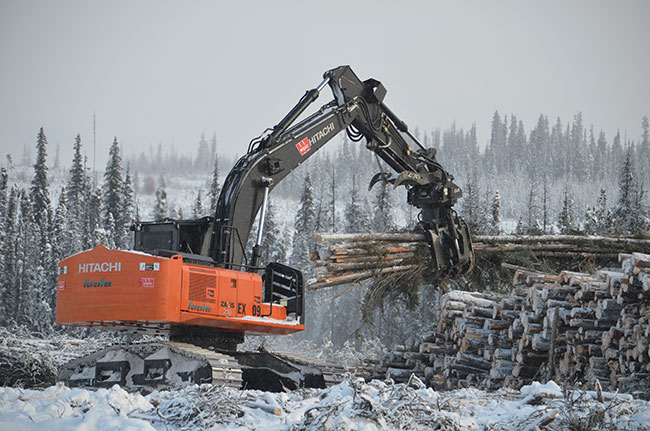
Features
Harvesting
New Gear
Current and future trends in log lifting equipment
December 27, 2021 By Andrew Snook
 Automating certain processes for log loaders to assist inexperienced operators is an area where OEMs are looking to improve productivity. Photo: Annex Business Media.
Automating certain processes for log loaders to assist inexperienced operators is an area where OEMs are looking to improve productivity. Photo: Annex Business Media. In the world of forestry, whether it’s a sawmilling operation or a logging operation, having the right equipment for sorting and stacking logs is vital.
To learn more about what fleet managers and their equipment operators are looking for in their log lifting equipment, Canadian Forest Industries reached out to equipment manufacturers and dealers to hear their thoughts on current and future trends.
Log loaders
Not unlike other types of heavy equipment, telematics management systems are starting to play a more pivotal role in the world of log loaders.
“If you look in the past, telematics came on board and customers were just looking for the ability to see their machines and get an idea of when they needed to do their next service, because the machine wasn’t in the yard and they didn’t know how many hours were on it,” says Jarvis de Groot, global product marketing manager for John Deere’s Construction & Forestry Division. “That’s progressed over time to today. They’re always looking for an enhancement on that telematics and what it can report. They want to be able to have remote diagnostic capabilities, even remote software updates. Machine health monitoring is probably the term for it – make sure their machine is not overheating, doesn’t have any fault codes, and if there are fault codes, they remote-in and do a preliminary diagnostic on it.”
He says that moving forward, telematics systems will continue to expand in terms of data collection for what a machine is doing, so fleet and operations managers can continue to better view the productivity levels of their machines and operators, while keeping a closer eye on job sites.
“They want to know what the machine is doing and what the status of the job site is,” de Groot says. “So, machine communication becomes very important. What has the feller buncher done today? What’s the log loader done today? What’s the species of the wood lot today? How much wood has been processed versus loaded out? All of that data, they want to report that. If they can get access to that information and then have live data down the road, it becomes really important.”
To assist customers with this type of reporting, John Deere has rolled out and continues to improve its TimberMatic Maps program.
“We’ve already got some customers working on that; it’s a big part of that solution. It’s productivity reporting, the status of the different machines and what they’ve done today, wood inventory, species and diameters of trees, volumes of wood. All of this kind of data is what’s now being asked for to be reported out through that telematics system,” de Groot says.
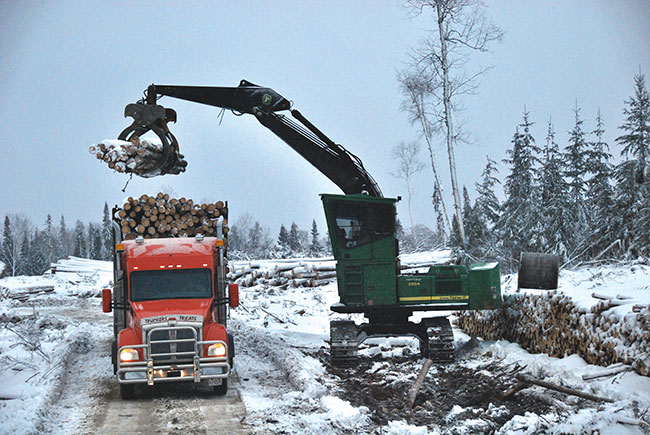
Not unlike other types of heavy equipment, telematics management systems are starting to play a more pivotal role in the world of log loaders. Photo: Annex Business Media.
Aaron Kleingartner, dealer and product marketing manager for Doosan Infracore North America, LLC, says that forestry professionals and logging companies are increasingly adopting this technology to improve their machine utilization, and access to these systems has greatly improved.
“Owners have access to the telematics system using a website or an app on a smartphone,” he says. “For example, an owner can use the app to see where a company’s log loaders are located on a map. The owner can click on a particular machine and review information about that machine, such as how much fuel it has left.”
Telematics systems are also extremely useful for the equipment dealers that sell and service the log loaders.
“Dealers receive updates when a log loader has an issue, such as when the machine displays a fault code,” Kleingartner says. “Dealers are better prepared to respond to service needs because they receive the fault code information and can address issues before dispatching a field service technician, if necessary. Some issues can be resolved by phone, resulting in log loaders getting back to work sooner.”
Automating certain processes for log loaders to assist inexperienced operators is another area where OEMs are looking to improve productivity for their customers, particularly in regions where qualified operators are hard to find.
“Some of those automated processes can make the operator a better operator quicker,” de Groot says. “Using that technology to get that operator to a place where he’s competent, that becomes a useful technology.”
Safety is another area where log loader technologies have been continuously progressing.
“Log loader manufacturers have added features like rearview cameras to help enhance operator visibility. The camera view is displayed on the LCD monitor inside the cab. This can be particularly useful when the log loader operator is working in a tight space or when they’re loading logs onto trucks,” Kleingartner says. “Some log loader manufacturers are developing all-around view monitors, similar to what some automotive companies are now offering in vehicles. This technology will further enhance the operator’s ability to see objects, such as other machines, workers, or trucks, near the log loader. The all-around view may require log loader owners to install a separate monitor from the standard LCD monitor.”
de Groot says the ability for strong data collection, along with machine-to-machine communication from not only log loaders, but all forestry equipment, will be a very big factor in setting the various OEMs apart in the future.
“To a large degree, we all build a good log loader, we build a good machine, so how do we set ourselves apart? It’s that technology part, being able to report on that productivity or whatever that machine is doing,” he says. “To me, that is only going to continue over time.”
Yarders
As less fibre becomes readily accessible, logging contractors have had to move to steeper slopes. This is particularly true in B.C. One of the ways contractors tackle this challenge is through the use of yarders.
Del Penner of B.C.-based Integral Equipment, which supplies the Alpine Shovel Yarder and Alpine Grapple Carriage to North America, says that changes have been made to make yarders accommodate contractors’ needs.
“The industry has really gone to steep slopes,” he says. “Changes in yarders include them being smaller, more operator friendly and quicker to move. That’s the market we’re after,” he says.
The latest model of yarder that Integral Equipment offers is a two-drum interlock mounted on an excavator. This swinging yarder system can yard 450 metres with a 3/4-inch superswage haulback and mainline without needing guy lines.
Penner says yarder equipment needs to be more operator friendly than ever, since many of the veteran contractors are retiring and are being replaced with less experienced steep slope operators.
“A lot of the old traditional yarders, I think there’s a lot of that generation that’s going to be moving on and retiring, and there are a lot of contractors that are new to steep slopes that are traditionally conventional loggers, so I think it needs to be operator friendly,” he says.
Pedestal loaders
At sawmill yards, pedestal loaders offer a low-emissions solution in a world where carbon footprints continuously become a bigger factor for forest products manufacturers to consider.
“Tanguay has always been manufacturing pedestal loaders for the mill yard, and the pedestal loaders have always been electric, on the grid with hydro,” says Daniel Chastenais, vice-president of sales and marketing for Machinerie Tanguay headquartered in Roberval, Que. “With carbon critics, it’s important there’s some saving for emissions.”
The mobile Tanguay rail trolleys are designed to handle logs, chips and a variety of other materials. They can be used in standard sawmills, as well as other specialty wood product plants like oriented strand board (OSB) mills where shorter logs need to be picked up and placed in vats to treat them in hot water, then picked up again and fed into a debarker or strander.
“We have an OSB mill that has been using it to build a huge inventory at the mill entrance,” Chastenais says. “They give mills the versatility of mobile equipment. Clean and safe, these loaders can be used for several mill entrances.”
Tanguay rail trolleys can also be used to unload logging trucks from the top to feed into the mill.
“It’s very innovative,” Chastenais says.
Spotlight on log lifting
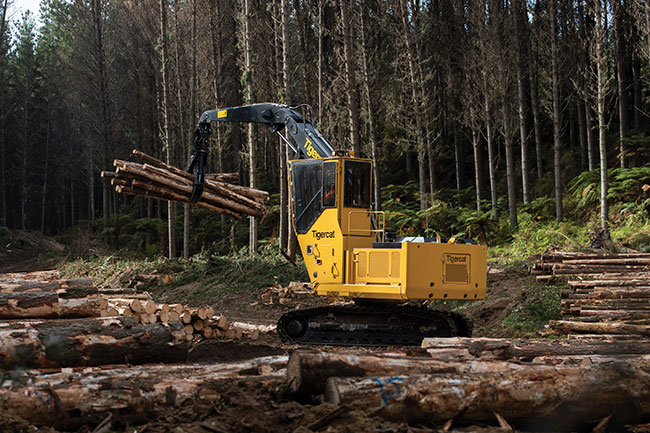 Tigercat
Tigercat
A purpose-built logger, the Tigercat 865 will offer many advantages over excavator conversions, including better service access, stronger swing torque and superior operator visibility. The Tigercat FPT N67 engine delivers 165 kW (221-hp) at 1,900 rpm. The 865 logger can be configured as a loader with boom options for various grapple types, or as a high-capacity processor, capable of running large harvesting heads in demanding duty cycles. Dual swing drives will provide ample torque and speed for high-performance loading or processing. Service access has been carefully thought out with the ability to step down into the centre of the machine for clear, unobstructed access to the engine and daily service points. Large enclosure doors and a spring assist side service platform provide a large, stable work area for performing maintenance on hydraulic components and changing filters. A large cast counterweight provides excellent stability with a swing-out door that allows access to the engine from the rear of the machine. The rear entry elevated cab, full-length front window, and additional floor windows provide superior visibility with clear sightlines. LED lighting and the rearVIEW camera system further augment operator visibility.
www.tigercat.com
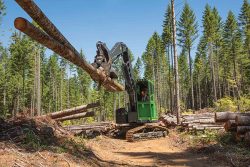 John Deere
John Deere
The purpose-built G-Series Forestry Swing Machines are available in crawler log loader or forestry excavator configurations, able to integrate with valve-in-head and live heel log grapples, processing heads, and bucket and thumb combinations. Excellent access, egress, visibility, operator protection, and comfort can be achieved in both the low side-entry cab and the elevated rear-entry cab options. The cab-forward riser option on the 2156G, 2656G, and 3156G moves the operator 17 inches forward, and the increased tractive effort on the 2156G and 2656G helps overcome steep terrain.
www.deere.com
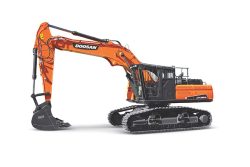 Doosan
Doosan
Doosan road builder models provide forestry customers with the ability to pioneer tracts of land more efficiently due to the larger sizes and increased productivity. For example, the DX300LL-5 road builder provides customers with more reach and the ability to pair the machines with larger buckets for enhanced performance and clearing abilities. Road builders are often the first forestry machines onsite before work begins on a new tract of land. They clear trees and build roads to make a path for other forestry equipment to reach the trees scheduled to be harvested. To complete the clearing work, road builders are regularly outfitted with quick couplers, buckets and thumbs (clamps). Forestry cabs are available in areas that require them. www.doosanequipment.com
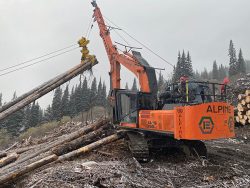 Integral Equipment
Integral Equipment
B.C.-based Integral Equipment supplies the Alpine Shovel Yarder and Alpine Grapple Carriage to North America. Although new to North America, the Alpine product line has been thoroughly tested globally. The latest model is a two drum interlock mounted on an excavator. This swinging yarder system can yard 450 metres with a 3/4-inch superswage haulback and mainline, without needing guy lines. The Alpine winches’ drive system is what sets it apart. Winch technology provides smooth lift, high speeds, and braking without producing excessive hydraulic heat and wear and tear. Matched with one of the Alpine Grapples, this yarder is a very mobile productive steep slope solution.
www.integralequipment.ca
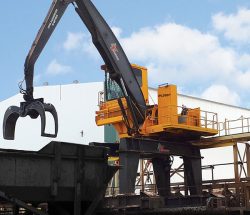 Tanguay
Tanguay
Mounted on a fixed single-pedestal mount or large dual-post mount, Tanguay’s Electrical Knuckle Boom Loaders and Rail Trolley loaders are extremely efficient and economical to handle logs, chips or various materials. The mobile Tanguay rail trolley can expand working range and increase mill flexibility. The Tanguay PL350 and PL350-HD comes with an extra-large ergonomic cab with plenty of room to install mill input and outputs screens and controls. The electrical system is available for worldwide electrical services. Tanguay offers an experienced engineering team, custom boom designs and a proven record of reliability, low operating costs and long life to optimize mill infeed and maximize production.
www.tanguay.cc
Print this page
